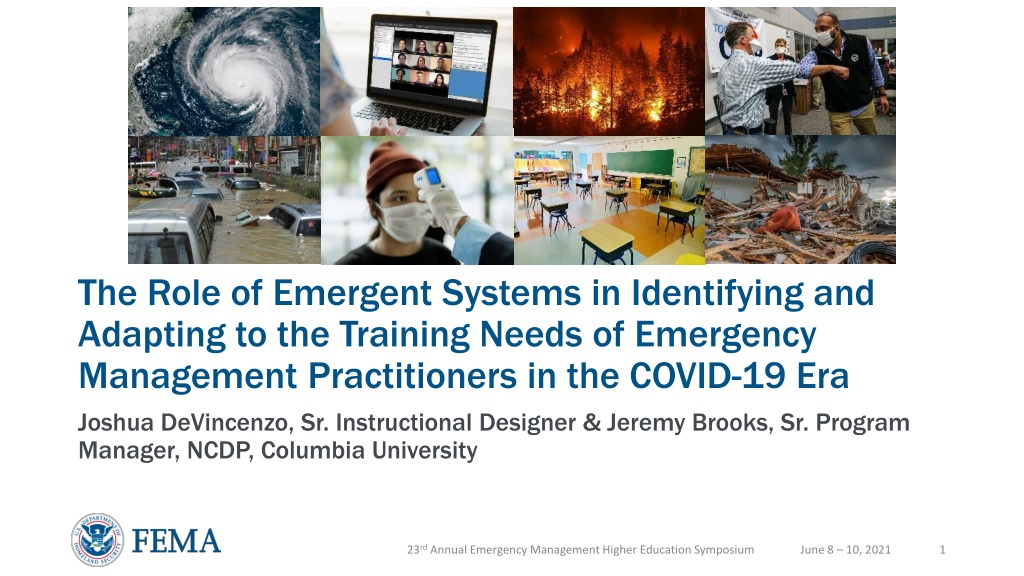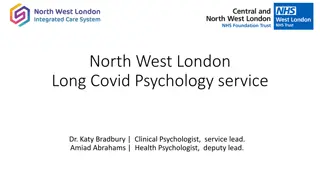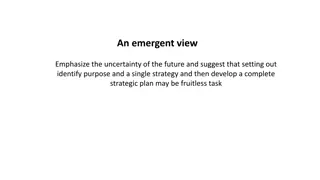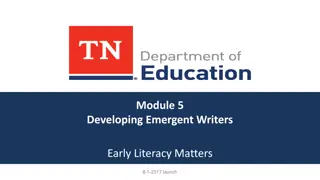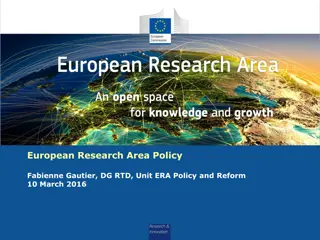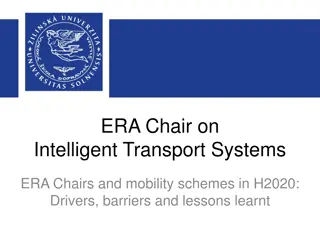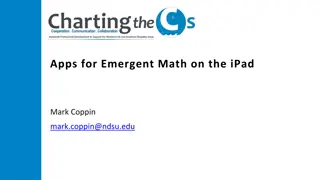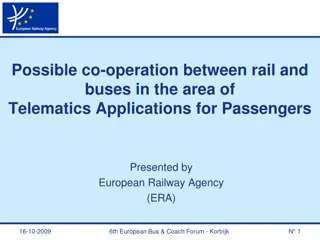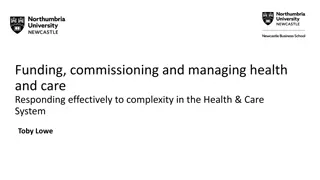Emergent Systems for Training Needs in COVID-19 Era
Explore how emergent systems can identify and adapt to the training needs of emergency management practitioners during the COVID-19 era. The symposium delves into analyzing feedback from pandemic-era trainings, aligning emergent themes with national preparedness assessments, and offering recommendations for teaching and learning in Emergency Management amidst the pandemic. The NCDP's history, research initiatives, and training programs are highlighted, emphasizing the importance of translating science into practice.
Download Presentation

Please find below an Image/Link to download the presentation.
The content on the website is provided AS IS for your information and personal use only. It may not be sold, licensed, or shared on other websites without obtaining consent from the author. Download presentation by click this link. If you encounter any issues during the download, it is possible that the publisher has removed the file from their server.
E N D
Presentation Transcript
The Role of Emergent Systems in Identifying and Adapting to the Training Needs of Emergency Management Practitioners in the COVID-19 Era Joshua DeVincenzo, Sr. Instructional Designer & Jeremy Brooks, Sr. Program Manager, NCDP, Columbia University 23rd Annual Emergency Management Higher Education Symposium June 8 10, 2021 1
Scope and Learning Objectives Discuss emergent training topic areas of interest analyzed through evaluation feedback gathered from trainings throughout the pandemic. Analyze findings from cross-referencing emergent themes gathered from learners with national preparedness assessments. Provide recommendations for the scholarship of teaching and learning in Emergency Management to adapt and address the learning needs of curriculum during a COVID-19 era based on adult learning theory and informed by actively conducting trainings throughout the pandemic. Presenter s Name, Title June 8 10, 2021 2
Context: Organizational History Originally funded as a CDC Center for Public Health Preparedness, 2001-2010 CDC funded Preparedness and Emergency Response Learning Center, 2010 - 2014 Established a Learning Management System with over 40 courses offered and over 100,000 users trained domestically and internationally Home - National Center for Disaster Preparedness | NCDP (columbia.edu) NCDP Training Center (FEMA Courses) (ncdpcourses.org) Presenter s Name, Title June 8 10, 2021 3
Translating Science into Practice National Disaster Readiness Surveys conducted annually for many years providing a detailed snapshot of U.S, population readiness for disasters. Conducting some of the largest longitudinal cohort studies to follow the trajectory of children s recovery after Katrina and the Deepwater Horizon Oil Spill. Staff have served as principal investigators on research and training projects with the CDC, ASPR, the New York City Department of Health and Mental Hygiene, Commonwealth Edison Co, and GSK. Presenter s Name, Title June 8 10, 2021 4
NCDP Training Program Overview FY16 - Community Planning for Economic Recovery: 2016 - 2019: 1 Instructor-Led Training (ILT) and 2 Web-Based Trainings (WBT) FY18 - Improving Individuals and Business Financial Literacy and Management to Support Post-Disaster Economic Recovery: 2018 - 2021: 2 ILTs and 2 WBTs FY17 - Addressing Gaps in Housing Disaster Recovery: 2017 - 2020: 1 ILT and 3 WBTs FY19 - Innovative Disaster Recovery Strategies for Interim and Permanent Housing Construction: 2019 2022: 1 ILT and 1 WBT FY18 - Transitioning Disaster Survivors from Temporary to Permanent Housing: 2018 - 2021: 2 ILTs and 2 WBTs FY20 - Designing and Administering Custom Housing Programs for State, Tribal, and Territorial Governments: 2020-2023: 1 ILT and 2 WBTs Presenter s Name, Title June 8 10, 2021 5
Who are our Learners? Learning Management System Demographics Discipline of NCDP Learners Government Level of NCDP Learners Citizen/ Community Volunteer (CV) Special District (SD) Public Safety Communications (PSC) Information Technology (IT) Military (M) Private Sector (PSP) Self-Reported Government Level Tribal Nation (T) Public Works (PW) Self-Reported Discipline Federal DHS (DF) Education (E) Emergency Medical Services (EMS) International (I) Private Sector/Corporate Security and Safety Professionals Federal FEMA (FF) Fire Service (FS) Agricultural Safety (Pre and Post Harvest) (AGS) Not Applicable (NA) Citizen/Community Volunteer (CV) Statewide/Territorial (S) Law Enforcement (LE) Public Health (PH) Private Sector (P) Healthcare (HC) Federal (Non-DHS) (NF) Governmental Administrative (GA) Not Applicable (NA) Other (OTH) Emergency Management (EM) Local Government (L) 0% 5% 10% Percentage of Learners in Discipline 15% 20% 25% 30% 35% 40% 0% 5% 10% 15% 20% 25% 30% 35% Percent of Learners in Self-Reported Government Level Category N = 3,289 learners as of 5/13. States with most learners: FL, TX, NY FEMA Region with most learners: 4 (AL, FL, GA, KY, MS, NC, SC, TN). Presenter s Name, Title June 8 10, 2021 6
Emergent ThemesBeyond Systems Thinking Emergent systems are often portrayed with gears. Each gear consists of properties in isolation. However, when combined, a number of newer properties emerge (O'Reilly & Munakata, 2000). The result is unearthing an emergent phenomenon from interactions that are not present in an isolated component but are activated when combined (O'Reilly & Munakata, 2000). Presenter s Name, Title June 8 10, 2021 7
Emerging Themes in EM: THIRA/SPR Threat and Hazard Identification and Risk Assessment (THIRA) and Stakeholder Preparedness Review (SPR), is an annual assessment of hazards of interest and stakeholder capacity. Some themes (housing, economic recovery) were also found in learner evaluations from trainings. From THIRA/SPR 2019 Results and Presentation: Consistent with past results, states/territories tend to report the most significant gaps in the Recovery core capabilities and the fewest gaps in the cross- cutting core capabilities Randazzo, D. (2019, November). Thira/Spr Program and Results. Homeland Security National Training Program (HSNTP) Kick-Off Meeting. Washington; District of Columbia.
Emerging Themes in EM: Learner Evaluations Figure 1: Emerging Topics Identified in Qualitative Coding of Evaluation Data Compared with THIRA/SPR Economics Coded Areas of Intetest Identified Housing THIRA/SPR - Long-term housing Stakeholder engagement Business Resilience THIRA/SPR - Reopen Businesses Tools and Frameworks Mitigation Federal programs and procurement THIRA/SPR - Recovery core capabilities Recovery Planning 0 5 10 15 20 25 30 35 40 45 50 Number of mentions of code in Areas of Interest in Evaluations Evaluation Areas of Interest Similar to THIRA/SPR gaps Evaluation Areas of Interest
Recommendations and Insights for SoTL Move towards Action learning approaches that are conducted by using past knowledge supplemented by insights from questioning the current complexity (Revans, 1982). Adapt training and education to reflect the modern threat and hazard environment Continual evaluation and direct feedback through formative and summative assessments. Flexible curriculum and learning objectives Revisit models and definitions Presenter s Name, Title June 8 10, 2021 10
Contact Joshua DeVincenzo, M.Ed. Sr. Instructional Designer jld2225@columbia.edu Jeremy Brooks, MPH Sr. Program Manager jb3860@Columbia.edu DeVincenzo & Brooks June 8 10, 2021 11
